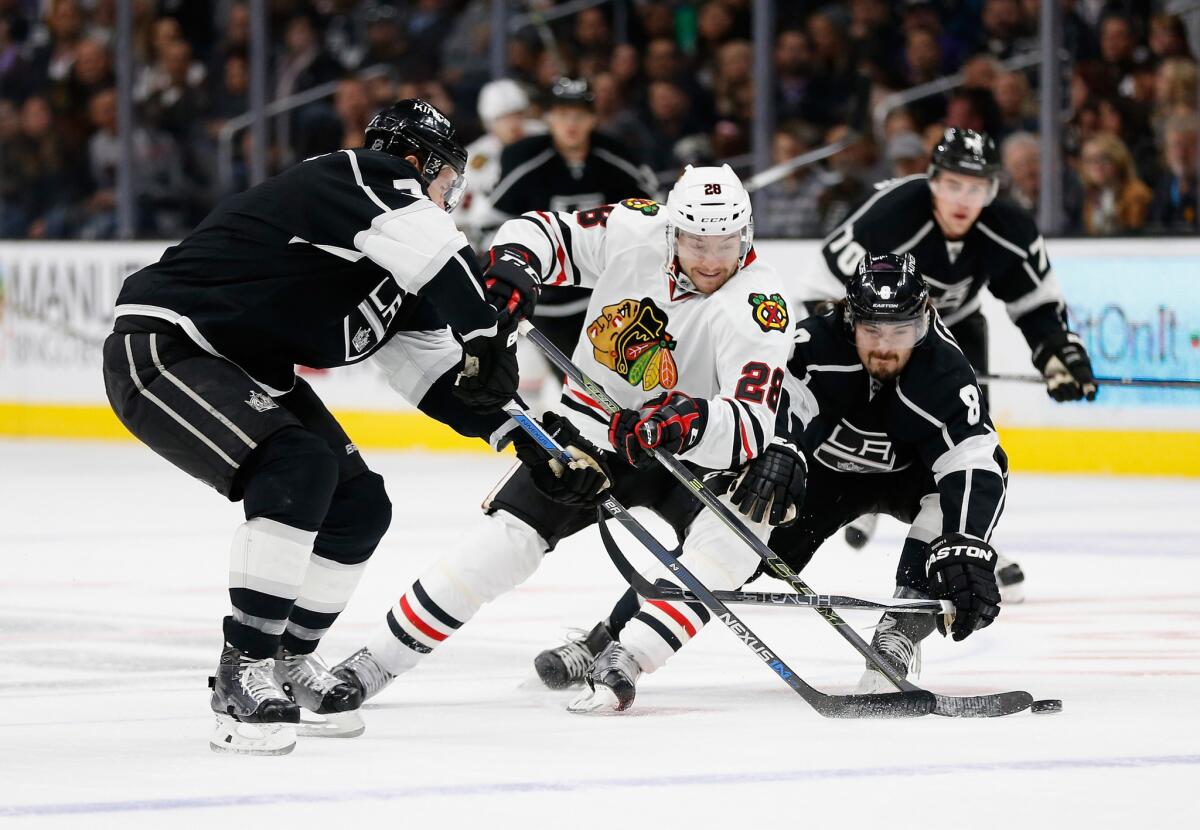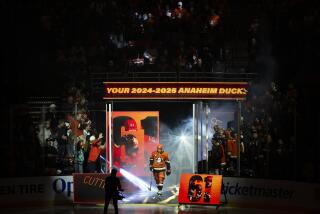Ducks’ trade moves seem designed to make them tougher, and more could be on the way

Chicago forward Ryan Garbutt battles with Kings defensemen Drew Doughty (8) and Brayden McNabb (3) during a game on Nov. 28. Garbutt was traded to the Ducks on Jan. 21.
They were hardly blockbuster moves, perhaps more of a prelude to what could come before the Feb. 29 trade deadline. But they certainly got the Ducks’ attention.
In a span of six days this month, Ducks General Manager Bob Murray traded speedsters Carl Hagelin and Jiri Sekac in separate transactions for David Perron and noted pest Ryan Garbutt.
In talking about Garbutt, Murray cited a need to play a harder style, a nod toward the physical ethos of their 2007 Stanley Cup run.
It said everything about a team that has gone from leading the NHL in scoring two seasons ago to the grinding approach it apparently will take in its post-All-Star break push that begins Tuesday.
“I think that’s where we’re going,” center Andrew Cogliano said. “I think we’ve always been a team that’s prided ourselves on playing hard, playing the cycle, being harder on forecheck. I think we’re getting back to that a little bit. With Hagelin and Jiri, that’s not to say those guys didn’t want to play like that. [But] I think our identity is forming a lot better right now. It’s the identity that we’re all used to. Bob and [Coach] Bruce [Boudreau] know how we need to play. Now guys need to fall in line.”
That line was forming just before the break as the Ducks scored 23 goals in six games to bump their average to more than two goals a game [2.11]. They’re still last in the NHL, and Cogliano cautioned against a small sample size.
“It’s too early to tell,” he said.
But with strong defense and goaltending, the Ducks might be the team no one wants to face in the playoffs. They just have to get there first. They are two points behind third-place Arizona in the Pacific Division for a playoff spot, and further behind in the wild-card race.
That could mean trading for an offense-minded piece. Corey Perry, Rickard Rakell and a surging Ryan Kesler account for 41 of their 99 goals. Captain Ryan Getzlaf is still looking for his first even-strength goal.
Murray is known for being active and will have a surplus of defensemen as bargaining pieces. Two of those, Hampus Lindholm and Sami Vatanen, are set to become restricted free agents this summer, as are Rakell and goalie Frederik Andersen.
For now, Boudreau has found success by breaking up Getzlaf and Perry to balance the attack. Perry has been particularly effective with Rakell, and Kesler seemed to re-emerge as an offensive force just before the break.
“I think we’re harder to check at this stage with the lines the way they are,” Boudreau said. “All three of those lines are scoring.”
Boudreau didn’t have to check the schedule to rattle off what the Ducks face from Feb. 24 to the end of the regular season.
“Twenty-three games in 46 days,” he said.
Anaheim has only two instances of two days off between games in that span, and it has a makeup game at Washington to schedule. The Ducks play 20 of their final 35 games on the road and have four left against the division-leading Kings, three of those at Staples Center.
“It’s going to be a challenge and we’re going to find ways to rest every chance after this break,” Boudreau said. “The most important thing is to keep them fresh and not to lose energy for the games.”
Fresh defensemen shouldn’t be an issue at the outset. When Cam Fowler returns from a knee injury after the break and Clayton Stoner recovers from a hip injury, the Ducks will be fully healthy on defense for the first time this season with eight defensemen.
That gives Murray a tough choice on whether to keep Shea Theodore in the minors or with Anaheim, where he has shown precociousness in his first 13 games and appears to be the team’s power-play quarterback in waiting.
Theodore, 20, does not have to clear waivers to be reassigned. He has two goals and four assists and averages 18 minutes 31 seconds of ice time per game.
“He comes up and he actually plays a more structured style in the NHL . . . [because] the AHL is a bit scrambly,” Murray said. “He’s fit in quite nicely. He moves the puck quite well and he’s good on the power play.
“Interesting decisions to make going forward here.”
Follow Curtis Zupke on Twitter @CurtisZupke
More to Read
Go beyond the scoreboard
Get the latest on L.A.'s teams in the daily Sports Report newsletter.
You may occasionally receive promotional content from the Los Angeles Times.







